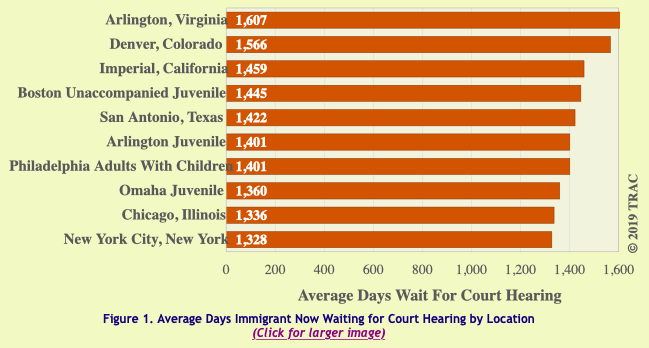Read more about InAlienable.Support Quixote Center’s InAlienable program!
InAlienableDaily Dispatch
October 28, 2019

Trump policies clogging courts
If you are awaiting a hearing date in Arlington, Virginia’s immigration court, you will not get in before December 18, 2023. In Chicago or Houston? December 20, 2023. Yes, immigration courts are so backed up with cases that in the largest districts, wait times for court dates are 4 years and growing:
The Arlington court exemplifies the rising backlog and wait times. At the end of April 2017 there were 28,272 pending active cases. This grew to 32,012 at the end of May 2018, and grew further still to 39,131 as of the end of September 2019. Projected average wait times have increased from 1,165 days in April 2017 to 1,400 days in May 2018, and finally to 1,607 days - or 4.4 years - in September 2019. Hearings are being scheduled as far out as December 18, 2023.
Why the backlog? It is NOT the result of people seeking asylum from Central America. The numbers seeking asylum have increased to be sure, but the backlog in immigration courts is primarily the result of Trump administration policies.
While many sources for this rise are outside the court's control, policy decisions and practices by the Department of Justice which oversees the Immigration Court have significantly contributed to growing caseloads. For example, additional cases were added to the pending backlog when the Trump Administration decided to "open" many hundreds of thousands previously "closed" cases. Many of these cases have not yet been calendared so they don't show up on court backlog records. When the 322,535 cases that remain to be calendared are added, the current backlog climbs from 542,411 at the start of the Trump Administration to 1,346,302 cases today - a whopping 148 percent increase. (Emphasis added)
The decision to reopen previously closed cases has single-handedly exacerbated the immigration court crisis, yet it has not received sufficient attention. This single policy decision has caused a much greater increase in the court's backlog than have all currently pending cases from families and individuals arrested along the southwest border seeking asylum.
There are a reported 214,855 of these cases that originated through credible fear claims now pending before the court. Those who arrived during the recent months of the Trump Administration represent only part of this total. Despite the intense public focus on asylum cases originating at the U.S.-Mexico border in recent months, their contribution to the immigration court backlog is clearly substantially fewer than the untold number of cases put back into the judges' workload when the current administration decided to unilaterally reopen long- closed cases.
The backlog also means that immigration judges have a huge caseload. If one includes all cases pending before the system (including reopened cases not yet calendarized) the backlog is over 3,000 cases a judge. So, even if no new cases come in, at the current “quota” of 700 cases a year the administration expects judges to clear, it would take 4.4 years for judges to catch up. The Transactional Records Access Clearinghouse at Syracuse University has the full report here.
Trump administration makes it even harder for poorer immigrants
The application fee for citizenship is currently $1,225. To get a green card, it is $775. While about the same price as a toilet fixture at Trump’s house, for most other people, that is a lot of money. USCIC has had a program for many years that allowed people to get a waiver of these fees if they also received some form of public assistance. The logic is simple, if already qualified for a means tested program, there should be no need to reapply to get the fee waived.
USCIS just ended that program. As a result, about two-thirds of the people who receive the waiver today will likely not be able to qualify now. Or, at least, the process has been made much more difficult. Under a new rule, even people who take part in means tested programs will have to apply separately to demonstrate financial need. This will, of course, extend the process, costing the government more money in processing. But it will also make it that much harder for some immigrants to apply for citizenship or permanent residence - and that is of course the goal. From Vox:
“Once again, the administration is using every lever it can find to restrict legal immigration,” Doug Rand, a former White House official who worked on immigration issues in the Obama administration, said in a statement. “The obvious purpose of this latest action is to make it more difficult for low-income green card holders to apply for U.S. citizenship, in a way that sidesteps the typical rule-making process where [the administration] has been so often frustrated in court.”
It’s one of several policies the Trump administration has pursued recently targeting low-income immigrants. The same article in Vox provides a good summary of these measures.
The administration’s “public charge” rule, published in August and recently blocked in federal court, would have given immigration officials much more leeway to turn away immigrants applying to enter the U.S., extend their visa or convert their temporary immigration status on the basis that they are likely to end up depending on public benefits. Researchers estimated it could have affected more than 382,000 people.
President Donald Trump issued a proclamation earlier this month barring immigrants who do not have health insurance and cannot afford to pay medical care costs from getting visas of almost any kind to enter the U.S.
And he issued another executive order in September allowing states that do not have the resources to support refugees in becoming “self-sufficient and free from long-term dependence on public assistance” to turn them away.
